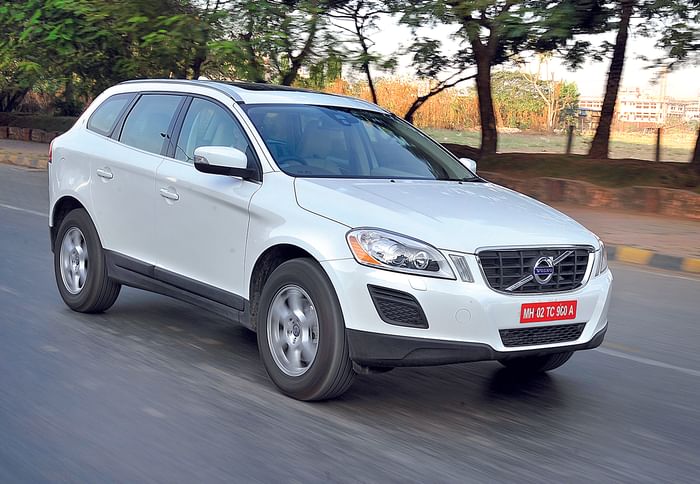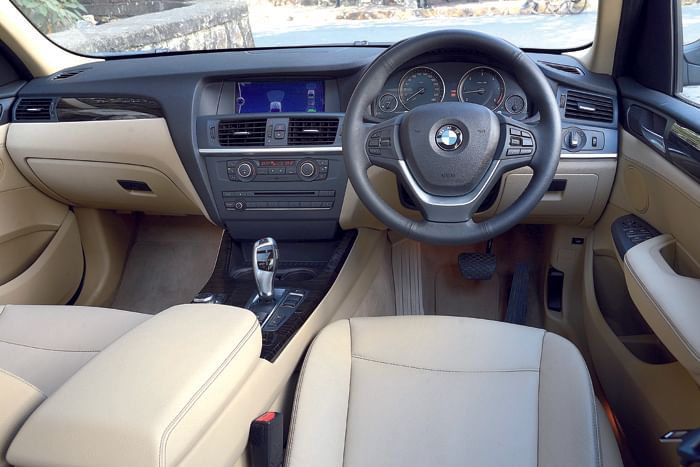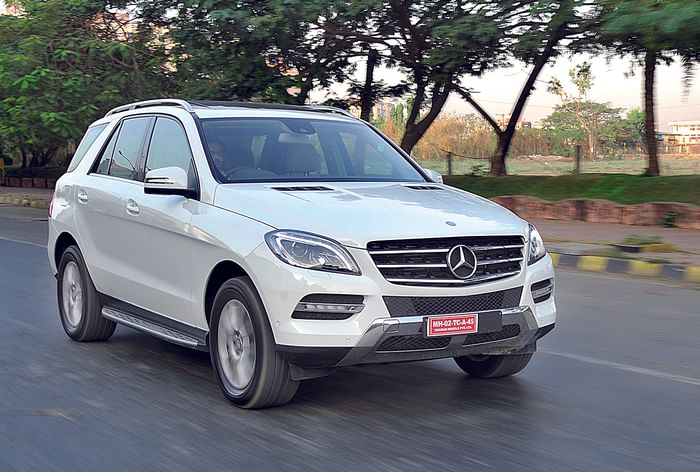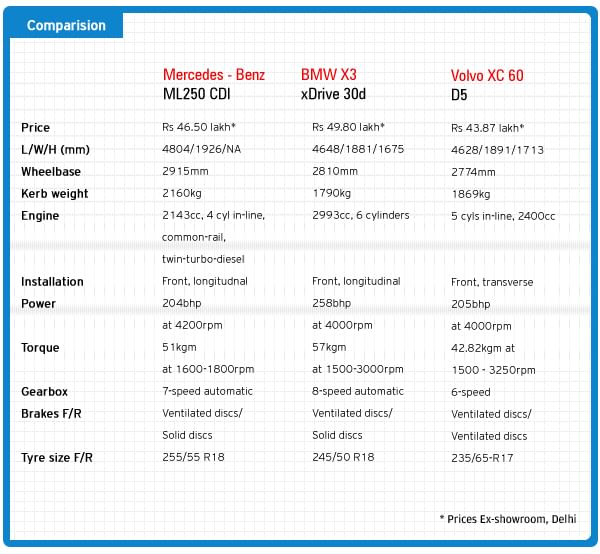Mercedes ML250 CDI vs BMW X3 vs Volvo XC60
The ML 250's downsized engine and price drops it down a class. But can it beat the current class contemporaries?
Published On Feb 06, 2013 05:47:00 PM
1,37,340 Views
Follow us on



![]() By Staff Writer
By Staff Writer
Overview
With the Indian SUV segment growing in leaps and bounds, carmakers are constantly churning out newer products for the domestic market. Consequently, apart from the regular SUV offerings, premium off-roaders are also making their way here. So we pit three contemporaries – the Mercedes-Benz M-class, the BMW X3 and the Volvo XC60 – against each other to tell you which makes for the best buy.
The Merc M-class is a size bigger than the BMW X3 and Volvo XC60 and has traditionally been a rival to the larger (and more expensive) X5 and XC90 from BMW and Volvo respectively. So why are we comparing these SUVs? The answer lies in the ‘250 CDI’ badge on the M-class. This recently launched version of the M-class comes with a smaller and less powerful engine than the ML 350 CDI, but it also costs Rs 13 lakh less! That means you can have an ML for what you’d pay for the more powerful diesel versions of the smaller X3, XC60 and Audi Q5. We’d have liked to include the Q5 3.0 TDI in this test as well, but Audi did not have the updated version of the car that is scheduled to go on sale later this month.
What we seek to find out is if the smaller-hearted ML is too much of a compromise in terms of performance, or if it is actually a well-rounded premium SUV that just happens to be well priced too?
Performance
The ML 250 CDI is powered by a 201bhp, 2.2-litre, four-cylinder diesel engine rather than the 255bhp 3.0-litre six-cylinder diesel in the ML 350 CDI. It is the quietest and smoothest engine in this test and its performance is also surprisingly sprightly. Sure, the ML 250 CDI’s 8.8-second (approx.) 0-100kph time makes it around a second slower than the ML 350 CDI, but in most driving conditions you really can’t feel the power deficit. To be honest, it’s only when you stomp down on the accelerator at high speeds that you find the ML 250 CDI takes some time to gather more pace. If there’s a grouse, it is with the seven-speed automatic gearbox, which doesn’t respond quickly enough to sudden changes in throttle input. Even tugging on the beautifully finished paddle-shifters doesn’t help much to this end.
No such complaints with the BMW X3, whose eight-speed automatic gearbox is almost telepathic in the way it changes gears depending on the driving style you adopt. This and the 3.0-litre, six-cylinder engine’s impressive 258bhp of power make the X3 the fastest SUV in this trio, and by a considerable margin. Its 6.42-second 0-100kph time actually makes it quick enough to rival some sportscars! There’s also incredible pulling power at all speeds, so overtaking traffic is always just a prod of the accelerator away. But that’s not to say the X3 is perfect in this section of our test because the engine is relatively noisy.
Volvo’s XC60, in this more powerful guise, comes with a 2.4-litre, five-cylinder diesel engine with 204bhp of power. Drive the XC60 in an unhurried manner, and you’ll like the engine’s wide spread of power and its ability to pull forward at all engine speeds. If there’s a bugbear, it’s that the engine is a bit gruff and sounds strained when revved hard. The six-speed automatic gearbox also tends to feel a bit slow when you want instant power, and this reflects in the XC60’s performance numbers as well. It is the slowest through the gears and also takes a relatively long 9.9 seconds from 0-100kph.
Ride & handling
All three SUVs feel a bit unsettled on our potholed roads. The Mercedes ML 250 CDI uses steel springs for suspension. It does feel a bit firm at low speeds, but gets progressively better as you go faster. In true Merc fashion, the ML feels brilliant at highway speeds. You’ll also like the way the steering weighs up and goes from being very light at parking speeds to weighty and confidence-inspiring at high speeds. There’s also a nice fluidity with which the Merc changes direction. It’s not sporty by any means, but it doesn’t feel out of place in the bends like many SUVs of this size would. Unfortunately, the brakes aren’t very reassuring.
The X3, on the other hand, feels a lot sportier than the ML. It is agile, quick to change direction and relatively fun to drive on a twisty course. The steering also feels very well weighted at all speeds and, along with the suspension, can be fine-tuned to your liking. For most of the driving, we preferred to keep the X3 in Normal mode, where the steering feels light and the suspension is at its most absorbent. But even in this setting, the X3 tends to thump through bumps. This only gets worse when you switch to Sport or Sport+.
The Volvo XC60 also comes with three settings for its suspension and steering. In Comfort mode, there is some stiffness at low speeds, but on the whole, the ride is still pliant. Advanced and Sport modes do aid handling with better body control, but even then it doesn’t feel quite as entertaining as the X3. For its part, the steering feels well weighted on the move, but is heavier than the BMW’s and Merc’s at crawling speeds.
Off-road abilities on the three SUVs are quite limited at best. All three get all-wheel drive and hill-descent control, but the ML goes one step extra with an off-road mode that tweaks the ABS and ESP settings for rougher terrain.
However, none of them gets a full-size spare wheel – the ML 250 and XC60 feature space-saver spares and the X3, which uses run-flat tyres, comes without a spare wheel at all.
Interiors
The Merc ML has a high-set cabin and this means you need to use the footboard to climb in. But once inside, you’ll like the large and accommodating front seats for the comfort and great visibility they afford. You’ll also like the dashboard’s elegant design, though we weren’t taken by the colour combination on our test car. The cabin quality is fantastic, with millimetre-perfect panel fit and well-finished soft-touch plastics. The ML is the most spacious SUV here and this is most evident when you slide into the back seat, where the crucial few centimetres of extra kneeroom and width make all the difference. The seat itself is very comfy and is the only one here that can be reclined. A near-flat floor also aids middle-passenger comfort.
If you’ve been in a BMW before, you’ll feel a sense of familiarity in the X3. The dashboard looks like it could have been lifted from just about any other car in the range. But that’s no bad thing because it is logically laid out, with some neat detailing. Quality is really good too, with padded plastics for much of the cabin. A wide range of adjustments also makes it really easy to get comfy behind the X3’s meaty steering wheel. However, rear-seat passengers will have to contend with a high centre tunnel and a seat that offers insufficient thigh support. Also, since the front seats extend quite low, rear passengers can’t tuck their feet under these seats, further hampering comfort.
The Volvo’s cabin may not be as adventurously styled as its exterior, but it still feels quite special. And that’s largely to do with the XC60’s tough build and good fit and finish. The dashboard is neat too, with the ‘floating’ centre console being a unique element. Sadly, the plethora of buttons on that console can be confusing and hard to operate on the move. Where the Volvo does score big is seat comfort. The large, two-tone front seats are really comfy, while the well-shaped rear seat offers brilliant back and thigh support. But while the XC60 is a spacious car in its own right, it does lose out to the similarly sized X3 for rear kneeroom.
All three SUVs offer decent space for knick-knacks in the cabin, with big enough gloveboxes, bottle-holders in all four doors and storage bays between the front seats. The ML easily has the largest boot, though the X3 and XC60 don’t do too badly on this front either.
Buying & owning
All three SUVs can be specified with extra features and equipment, and this could drastically change what you finally pay for them. However, if you compare their base prices, it is the Volvo XC60 D5 that’s the cheapest, at Rs 43.87 lakh (ex-showroom, Delhi), and the BMW X3 3.0d at Rs 49.8 lakh that’s the most expensive. Priced at Rs 46.5 lakh (ex-showroom, Delhi), the Mercedes-Benz ML 250 CDI splits the other two on price.
Volvo also sells the XC60 with a smaller 2.0-litre engine. Prices for this version start at a very competitive Rs 36.47 lakh for the base Kinetic variant and extend to Rs 40.87 lakh for the better-equipped Summum model. Like the Volvo, the BMW X3 also comes with a 2.0-litre version that is priced at Rs 42.9 lakh. Mercedes-Benz M-class buyers who want more power have the option to buy the ML 350 CDI, which starts at Rs 56.9 lakh.
It’s important to note that Mercedes-Benz, BMW and Volvo only have a presence in the larger Indian cities, so service can be an issue if you stay in a smaller town.
This is undoubtedly a bigger problem for XC60 buyers, because Volvo sells cars in just eight cities. In comparison, Mercedes and BMW have 31 and 28 showrooms nationwide, respectively. The Mercedes and BMW also better the Volvo in terms of warranty. Where the ML 250 CDI and X3 come with a two-year/unlimited-km warranties, the XC60’s warranty runs for two-years/60,000km.
Verdict
There’s lots to like about the Volvo XC60. It looks great, comes loaded with features and is also the cheapest SUV here. Seat comfort is really good too and there’s little to complain about with its overall build quality. Where the XC60 does fall a tad short is in terms of performance. It’s safe to assume that anyone who buys the more powerful version of the XC60 would want it to be really quick and exciting to drive. Sadly, the XC60 doesn’t do all that well on this count, especially when viewed against the similarly-sized BMW X3.
The X3 is easily the enthusiast’s SUV here. It is not only the quickest, but also the most enjoyable to pilot. But if you look at the big picture, the X3 has its share of flaws. The engine, for one, is a bit noisy and rear-seat comfort isn’t all that great either. It’s also quite expensive.
And that’s exactly why the ML 250 CDI is our winner. It gets you the most SUV for the money and easily wins for comfort. It’s got really big seats, the most space and also the best-finished cabin. Overall refinement is also the best, and the performance is good enough to make you forget this is a 2.2-litre four-cylinder engine. The Merc ML 250 CDI may not be as exciting as the X3 or as well equipped as the XC60, but it strikes the best balance of performance, comfort and size, and that’s what makes it such an irresistible package.

Copyright (c) Autocar India. All rights reserved.


Comments
Member Login
Personal Details
No comments yet. Be the first to comment.